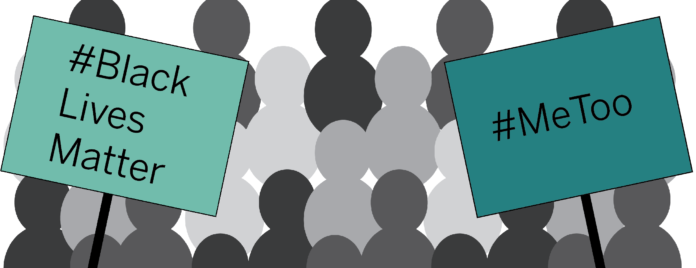By Lizzie Thomas | Staff Writer
Without the advent of social media, the enormous scale and grassroots reach of activist movements like Black Lives Matter and the Women’s March may not have been possible.
San Francisco junior Shevann Steuben is the president of the NAACP at Baylor. Though she has no direct involvement in the #BlackLivesMatter movement, in terms of leadership, she saw the power of social media in action as it grew.
“I believe in it, but it’s not a movement I surround my life with … The mission [of Black Lives Matter] is connected to NAACP, and obviously as a black woman, it’s important to me,” Steuben said.
Black Lives Matter started in 2013 as a response to the acquittal of the suspect in Trayvon Martin’s murder, George Zimmerman. The hashtag #blacklivesmatter grew as an organizing and mobilizing tool while tensions increased after Mike Brown’s death in Ferguson. Since then, the movement has developed into an organization with more than 40 chapters, the Black Lives Matter website says.
Steuben said she was excited as she saw people retweet about injustices and police brutality. She said she witnessed the movement grow as more and more people began to get on board and expose what she said was evident to her. This, she said, could not have happened without the grassroots nature of communication social media introduced to issues like injustices and oppression. It gave people connections, a voice and a platform that may not have been possible without a hashtag.
“Social media is great in terms of getting awareness out,” Steuben said. “I’m not a huge social media user, but the movement excited me because I saw it in progress. You have to get people aware to get social change. Technology furthers the word of mouth. I’ve seen social media touch more people.”
Black Lives Matter has a prominent platform, and Steuben said although it may not seem as discussed anymore and people may be numb to the situation, social media is still key in bringing issues of injustice forward.
Over time, the movement changed, as anything that owes its cultural rise to trending must.
“[Awareness is] still happening, but not on as big of a scale,” Steuben said. “The movement is shifting from talking about something that wasn’t talked about before at all to people knowing about it but trying to get people to still care about it.”
Steuben said Black Lives Matter’s task now is to continue to make sure people know about the injustices around the world and about discriminatory behavior as well as making sure the necessary action happens. She described the current posture of Black Lives Matter with a question: “Now you know — what are you going to do about it?”
Another hashtag-turned-social change is #MeToo. Countless news sources and politicians have discussed the concerns and changes of the #MeToo era. However, the movement had very little formal organization or news coverage from the start.
According to the Washington Post, the Women’s March on Washington started with a single Facebook post by retired Hawaii attorney Teresa Shook when Trump was elected, asking if her friends would be interested in a march at his inauguration. By the next day, thousands had responded to the event page.
The hashtag #MeToo came a little later after actress Ashley Judd accused entertainment mogul Harvey Weinstein of sexual harassment by breaking the story in the New York Times in October 2017. Ten days later, actress Alyssa Milano reignited the phrase “#MeToo” — after Tarana Burke coined it in 2006 to help other women of color recover from sexual violence — with the tweet: “If you’ve been sexually harassed or assaulted write ‘me too’ as a reply to this tweet.”
Berkeley Anderson, a local nonprofit worker and speaker at the Women’s March in Waco this year, said the #MeToo movement was already something she cared about and social media allowed her and others involved in organizing the event to promote the cause themselves.
“We were all trying to promote the event to get people to come, hear about [the #MeToo movement], and get interested in it as well,” Anderson said.
Anderson said each person was able to reach their own audiences and individual communities by using their personal social media accounts.
“It was more of a grassroots thing. We each said what we wanted to about the movement and trying to get other people to come [to march] as well,” Anderson said.






